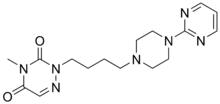Loading AI tools
Chemical compound From Wikipedia, the free encyclopedia
Eptapirone (F-11,440) is a very potent and highly selective 5-HT1A receptor full agonist of the azapirone family.[1][2] Its affinity for the 5-HT1A receptor was reported to be 4.8 nM (Ki) (or 8.33 (pKi)), and its intrinsic activity approximately equal to that of serotonin (i.e., 100%).[1]
 | |
| Clinical data | |
|---|---|
| Routes of administration | Oral |
| ATC code |
|
| Legal status | |
| Legal status |
|
| Pharmacokinetic data | |
| Elimination half-life | 2 hours |
| Identifiers | |
| |
| CAS Number | |
| PubChem CID | |
| ChemSpider | |
| UNII | |
| CompTox Dashboard (EPA) | |
| Chemical and physical data | |
| Formula | C16H23N7O2 |
| Molar mass | 345.407 g·mol−1 |
| 3D model (JSmol) | |
| |
| |
Eptapirone and related high-efficacy 5-HT1A full and super agonists such as befiradol and F-15,599 were developed under the hypothesis that the maximum exploitable therapeutic benefits of 5-HT1A receptor agonists might not be able to be seen without the drugs employed possessing sufficiently high intrinsic activity at the receptor. As 5-HT1A receptor agonism, based on animal and other research, looked extremely promising for the treatment of depression from a theoretical perspective, this idea was developed as a potential explanation for the relatively modest clinical effectiveness seen with already available 5-HT1A receptor agonists like buspirone and tandospirone, which act merely as weak-to-moderate partial agonists of the receptor.[1][2][3][4][5]
In the Porsolt forced swimming test, eptapirone was found to suppress immobility more robustly than buspirone, ipsapirone, flesinoxan, paroxetine, and imipramine, which was suggestive of strong antidepressant-like effects.[1] In this assay, unlike the other drugs screened, buspirone actually increased the immobility time with a single administration, while repeated administration decreased it, an effect that may have been related to buspirone's relatively weak intrinsic activity (~30%) at the 5-HT1A receptor and/or it's preferential activation of 5-HT1A somatodendritic autoreceptors over postsynaptic receptors.[1]
After repeated administration, high dose paroxetine was able to rival the reduction in immobility seen with eptapirone. However, efficacy was seen on the first treatment with eptapirone, which suggested that eptapirone may have the potential for a more rapid onset of antidepressant effectiveness in comparison.[1] Imipramine was unable to match the efficacy of eptapirone or high dose paroxetine, which was probably the result of the fact that higher doses were fatal.[1]
In the conflict procedure, eptapirone produced substantial increases in punished responding without affecting unpunished responding, which was suggestive of marked anxiolytic-like effects.[1] In addition, the efficacy of eptapirone in this assay was more evident than that of buspirone, ipsapirone, and flesinoxan.[1]
Eptapirone has been assayed in humans in preclinical trials at an oral dose of 1.5 mg.[6][7] In these studies, eptapirone reduced body temperature, prolonged REM sleep, increased cortisol and growth hormone levels, and produced side effects such as dizziness and drowsiness while being overall well tolerated.[6][7] It peaked rapidly within 30–60 minutes and had an estimated half-life of two hours, with a total duration of approximately three hours.[6][7]
Seamless Wikipedia browsing. On steroids.
Every time you click a link to Wikipedia, Wiktionary or Wikiquote in your browser's search results, it will show the modern Wikiwand interface.
Wikiwand extension is a five stars, simple, with minimum permission required to keep your browsing private, safe and transparent.